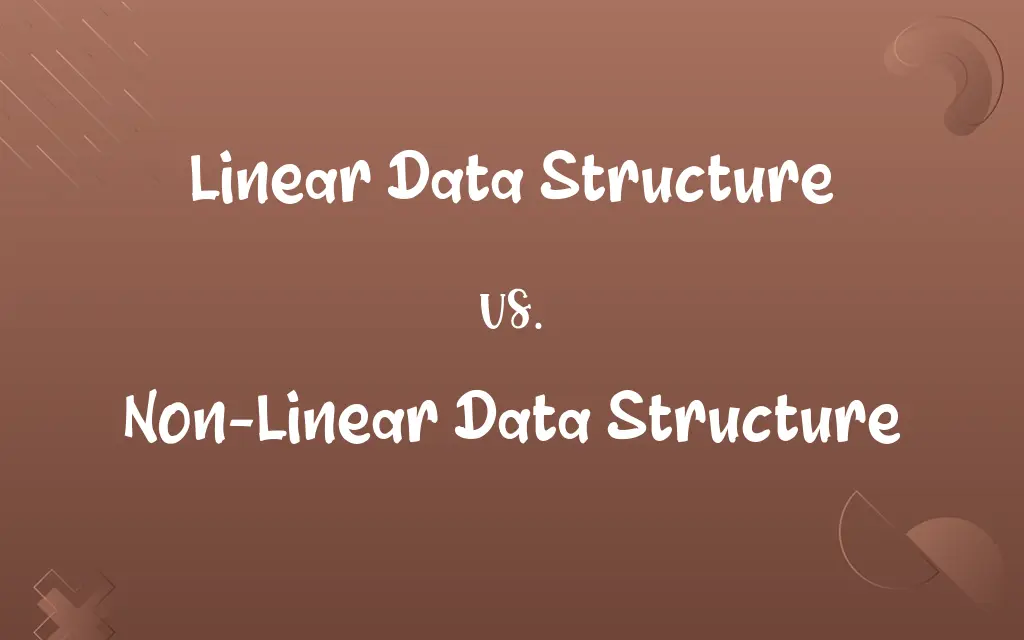Linear Data Structure vs. Non-Linear Data Structure: Know the Difference

By Dua Fatima & Shumaila Saeed || Published on March 6, 2024
Linear data structures store elements sequentially, allowing single-level traversal. Non-linear structures store elements hierarchically, supporting multi-level traversal.

Key Differences
Linear data structures, such as arrays, linked lists, stacks, and queues, organize data in a sequential manner, where each element is connected to its previous and next element in a single level. Non-linear data structures, like trees and graphs, arrange data in a hierarchical or interconnected manner, allowing for multi-level data organization.
Dua Fatima
Mar 06, 2024
This linear arrangement facilitates straightforward operations like insertion, deletion, and traversal, which can be performed in a sequential order. Linear structures are particularly efficient for scenarios where data needs to be processed in a specific order, such as in FIFO (First In, First Out) or LIFO (Last In, First Out) manners in queues and stacks, respectively. Non-linear data structures are characterized by their ability to represent complex relationships, such as hierarchical parent-child relationships in trees or networked connections in graphs. Non-linear structures are essential for modeling real-world scenarios like organizational structures, network routing, and family trees, where elements are not simply arranged in a sequence but have various levels of connection and interaction.
Shumaila Saeed
Mar 06, 2024
The primary difference between linear and non-linear structures lies in their data organization and traversal methods. Linear structures are traversed in a single run, from the first element to the last, making them intuitive and straightforward for simple data storage and access patterns. Non-linear structures, however, require more complex traversal algorithms, such as depth-first or breadth-first search in trees and graphs, to navigate through their multiple levels or interconnected nodes.
Shumaila Saeed
Mar 06, 2024
Linear data structures tend to be simpler to implement and understand, making them suitable for basic data storage and manipulation tasks. Non-linear structures, with their inherent complexity, are better suited for representing more complex relationships and scenarios, offering greater flexibility and functionality at the cost of increased complexity in implementation and operations.
Shumaila Saeed
Mar 06, 2024
Both linear and non-linear data structures are fundamental to computer science and are chosen based on the specific requirements and constraints of the problem at hand. For example, linear structures might be preferred for simple, ordered data operations, while non-linear structures would be chosen for complex, hierarchical, or networked data scenarios.
Dua Fatima
Mar 06, 2024
ADVERTISEMENT
Comparison Chart
Arrangement
Sequential, one element after another
Hierarchical or interconnected, multiple levels
Shumaila Saeed
Mar 06, 2024
Traversal
Single-level, straightforward
Multi-level, requires complex algorithms
Dua Fatima
Mar 06, 2024
Operations
Insertion, deletion, and access are linear
Insertion, deletion, and access can be complex
Dua Fatima
Mar 06, 2024
Use Cases
Simple, ordered data manipulation
Complex relationships and hierarchical data modeling
Dua Fatima
Mar 06, 2024
ADVERTISEMENT
Linear Data Structure and Non-Linear Data Structure Definitions
Linear Data Structure
Stacks follow a LIFO principle, ideal for undo mechanisms in applications.
Browser history where the last visited page is the first to be removed.
Dua Fatima
Feb 26, 2024
Non-Linear Data Structure
Directed Graphs (Digraphs) have directed edges, useful for web navigation.
A website structure where pages are nodes and hyperlinks are directed edges.
Dua Fatima
Feb 26, 2024
Linear Data Structure
Queues adhere to a FIFO principle, suitable for task scheduling.
Printer queue where tasks are processed in the order they were added.
Dua Fatima
Feb 26, 2024
Non-Linear Data Structure
Trees organize data hierarchically, perfect for file systems.
A directory structure where folders have subfolders and files.
Dua Fatima
Feb 26, 2024
Linear Data Structure
Arrays store elements in a contiguous memory location for easy access.
Storing a list of student names in a class.
Shumaila Saeed
Feb 26, 2024
ADVERTISEMENT
Non-Linear Data Structure
Undirected Graphs have edges that don't imply a direction, ideal for undirected networks.
Peer-to-peer networks where all connections are bidirectional.
Dua Fatima
Feb 26, 2024
Linear Data Structure
Linked Lists consist of nodes connected by pointers, allowing dynamic size adjustment.
A music player's playlist.
Shumaila Saeed
Feb 26, 2024
Non-Linear Data Structure
Graphs represent networks with nodes and edges, suitable for social networks.
Representing users as nodes and friendships as edges.
Shumaila Saeed
Feb 26, 2024
Non-Linear Data Structure
Binary Trees are a type of tree with at most two children, used in searching.
Binary Search Trees (BST) for efficient data retrieval.
Shumaila Saeed
Feb 26, 2024
Repeatedly Asked Queries
What is an example of a non-linear data structure?
A tree is an example of a non-linear data structure, where elements are organized in a hierarchical manner with parent-child relationships.
Dua Fatima
Mar 06, 2024
What is a linear data structure?
A linear data structure organizes data in a sequential order, where each element is connected to its predecessor and successor in a single level.
Shumaila Saeed
Mar 06, 2024
What is a non-linear data structure?
A non-linear data structure organizes data in a hierarchical or interconnected manner, allowing for complex relationships and multi-level data organization.
Dua Fatima
Mar 06, 2024
Can you give an example of a linear data structure?
An example of a linear data structure is an array, where elements are stored in contiguous memory locations.
Dua Fatima
Mar 06, 2024
Are non-linear data structures more complex than linear ones?
Yes, non-linear data structures are generally more complex due to their hierarchical or interconnected nature, requiring more complex algorithms for operations like insertion, deletion, and traversal.
Dua Fatima
Mar 06, 2024
Can linear data structures represent hierarchical data?
Linear data structures are not ideally suited for representing hierarchical data due to their sequential nature; non-linear structures like trees are better suited for this purpose.
Dua Fatima
Mar 06, 2024
How do linear and non-linear data structures differ in terms of traversal?
Linear data structures are traversed sequentially, from the first element to the last, while non-linear data structures require complex algorithms like depth-first or breadth-first search for traversal.
Hifza Nasir
Mar 06, 2024
Why would you choose a linear data structure over a non-linear one?
A linear data structure would be chosen for simple, ordered data operations where data is processed in a sequential manner, such as in queues and stacks.
Dua Fatima
Mar 06, 2024
How do graphs differ from trees in non-linear data structures?
Graphs represent networks with nodes and edges that may or may not be directed, allowing for cycles, whereas trees are a subset of graphs with hierarchical, parent-child relationships and no cycles.
Shumaila Saeed
Mar 06, 2024
When is a non-linear data structure preferred?
A non-linear data structure is preferred when dealing with complex relationships, hierarchical data modeling, or interconnected networks, such as in trees and graphs.
Dua Fatima
Mar 06, 2024
Share this page
Link for your blog / website
HTML
Link to share via messenger
About Author
Written by
Dua FatimaCo-written by
Shumaila SaeedShumaila Saeed, an expert content creator with 6 years of experience, specializes in distilling complex topics into easily digestible comparisons, shining a light on the nuances that both inform and educate readers with clarity and accuracy.








































































